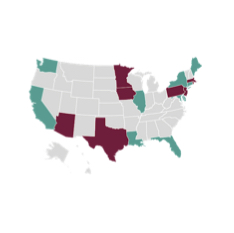What is Harassment?
Many workplaces should ask themselves the question, “What is harassment and what is not?” The dictionary defines harassment as annoying or bothering (someone) in a constant or repeated way. With such a vague definition, the word gets thrown around a lot. Since the definition is so vague we’re going to try and answer the question: what is considered harassment at work?
For example, when a telemarketer calls in the middle of dinner, you might say they are unlawfully harassing you. And we’ve all heard talk about online harassment – catfishing and trolling to name a few.
But what about harassment at work? What does it mean, and at what point does workplace harassment become unlawful?
The Types of Harassment: Unlawful or Not
You might be surprised to learn that not every instance of harassment at work qualifies as unlawful. There are two types of harassment: unlawful and not unlawful. Diving into three different scenarios, can you identify what is considered harassment at work, and which one is unlawful?
Three Scenarios of Harassment at Work
- Every day as soon as you go on break, your co-worker needs your help with something. When you don’t help them, they tell your boss and try to make you look bad.
- You were late getting a report for a client to your boss. The client is angry and so is your boss. This is the first time it’s ever happened, but now you’re in trouble. They call you into their office and raise their voice while telling you how you’ve disappointed them and lost the company money.
- Every week, your 22-year-old coworker sends an email to the whole office with a joke about people that are over 50. The latest one was about how all baby boomers need hearing aids.
What Constitutes Workplace Harassment?
Workplace harassment is a form of discrimination that violates various laws and can take many different forms. Generally, workplace harassment refers to any unwelcome behavior that is based on a protected characteristic, such as race, gender, sexual orientation, religion, or disability, and that creates a hostile or offensive work environment. Some examples of behaviors that may constitute workplace harassment include:
- Verbal harassment: This can include derogatory comments, slurs, or insults, as well as unwanted sexual advances, requests for sexual favors, or other sexually explicit language.
- Physical harassment: This can include unwanted touching, hugging, or kissing, as well as assault, or other physical acts that create an intimidating or hostile work environment.
- Visual harassment: This can include displaying offensive images or materials, such as posters, cartoons, or emails, as well as creating a work environment that is intimidating or hostile due to offensive or inappropriate decor.
- Cyber harassment: This can include sending harassing or offensive emails, texts, or social media messages, as well as posting derogatory comments or images online.
Overall, any behavior that is unwelcome and based on a protected characteristic, and that creates a hostile or offensive work environment, can constitute workplace harassment.
Laws Protecting Employees from Harassment
The United States Equal Employment Opportunity Commission (EEOC) has a very specific definition of what is considered harassment at work; the definition is clear about unlawful harassment:
“Harassment is unwelcome conduct that is based on a protected class. Protected classes include race, color, religion, sex (including pregnancy), national origin, age (40 or older), disability or genetic information [and gender identity].
And becomes unlawful where 1) enduring the offensive conduct becomes a condition of continued employment, or 2) the conduct is severe or pervasive enough to create a work environment that a reasonable person would consider intimidating, hostile, or abusive.”
So while you might consider the first two examples to be harassment, they don’t fit the EEOC definition of unlawful harassment examples.
Why Aren’t the Other Examples Considered Harassment?
First, an incident of harassment needs to include a protected class. In the first scenario, the offensive behavior was based on personal dislike (not helping when requested). But, in the third scenario, the harassment was referencing people over 50, which is a protected class.
Next, the harassment must occur frequently enough that it becomes hostile or abusive. In the second scenario, the offensive behavior (yelling) only happened one time. While in the third scenario, the emails were sent on a weekly basis.
How Could They Become Unlawful Harassment?
At this point, neither the first nor the second scenario is unlawful harassment. But if we uncover more details, they could become unlawful.
For the first scenario, if every time you didn’t help the co-worker and they complained to the boss stating that the reason you weren’t helping wasn’t that you were on break, but because of a stereotype saying people of your national origin are “lazy” and “rude,” that would be unlawful harassment.
And even if you didn’t know what the co-worker was saying and your boss didn’t have the same national origin, it would still be harassment based on a protected class.
For the second scenario, if while they are yelling, your boss says that your gender is limited in thought and can’t ever do as good a job as the other gender, and then proceed to say that they won’t fire you if you perform a sexual favor.
That would be unlawful harassment because sex is a protected class and a sexual favor is now a condition of employment.
Do Your Employees Know the Difference?
As the U.S. Department of Labor (DOL) states, what is considered harassment at work can be difficult for people to recognize due to the many different facets of each particular situation. Determining whether or not behavior crosses the line from ordinary workplace conflicts—like occasional uses of offensive language or a misplaced joke—to unlawful harassment is a complex process.
If your employees aren’t sure how to tell the different types of workplace harassment apart, it’s time for employee harassment training.
Focus on Culture
Ultimately, whether or not the first and second scenarios are defined as lawful harassment doesn’t matter because these “upstream” behaviors lead to unhealthy cultures and environments. As our research has shown, pervasive toxic behaviors arise from a negative culture. Shifting the focus towards creating a positive culture requires taking a preventive approach.
Now that we have a definition of workplace harassment, the next question we should be asking: how do you shape a healthy environment and workplace culture?


